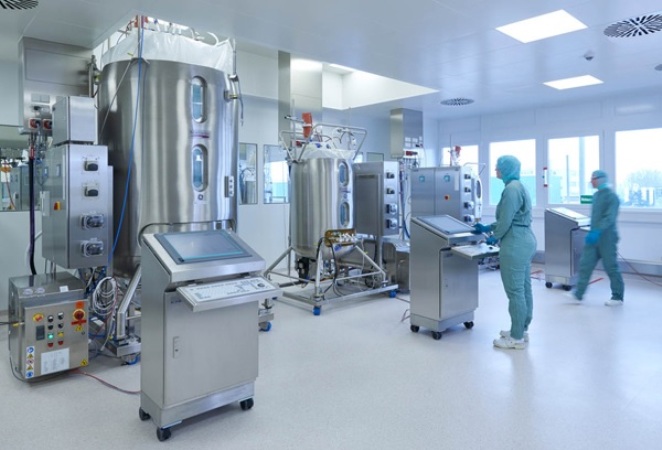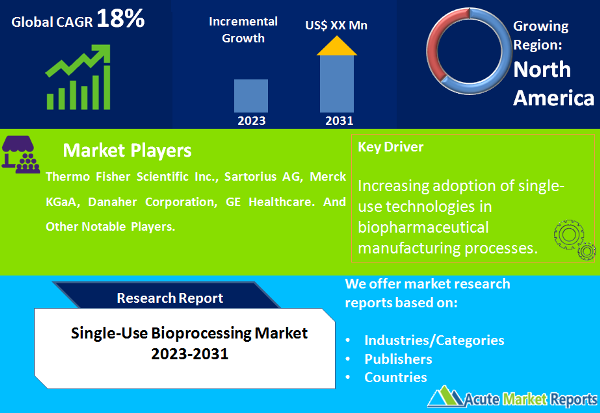
The single-use bioprocessing market is expected to witness a CAGR of 18% during the forecast period of 2025 to 2033, driven by the increasing adoption of single-use technologies in biopharmaceutical manufacturing processes. Single-use bioprocessing systems offer advantages such as flexibility, cost-effectiveness, reduced cross-contamination risk, and simplified cleaning and validation processes. These factors have contributed to the market's revenue growth, and the market is projected to experience a steady rise in the coming years. One of the key factors driving the market is the rising demand for biopharmaceuticals. Biologics, including monoclonal antibodies, vaccines, and cell and gene therapies, are gaining prominence in the pharmaceutical industry. Single-use bioprocessing systems provide a more efficient and adaptable solution for the manufacturing of these complex biologics, compared to traditional stainless-steel systems. The increasing demand for biopharmaceuticals, coupled with the advantages offered by single-use bioprocessing technologies, fuels the market's revenue growth. Furthermore, the growing emphasis on cost reduction and operational efficiency in biopharmaceutical manufacturing has propelled the adoption of single-use bioprocessing systems. These systems eliminate the need for extensive cleaning, sterilization, and validation processes associated with traditional stainless-steel systems. By eliminating these steps, manufacturers can significantly reduce turnaround times, minimize downtime, and increase overall productivity. The cost-effectiveness and streamlined workflow provided by single-use bioprocessing systems contribute to their increasing adoption and market revenue. Factors such as technological advancements in single-use technologies, the growing focus on personalized medicine, and the expanding biopharmaceutical manufacturing sector are driving the market's growth potential. Manufacturers are continuously investing in research and development to enhance the performance, scalability, and robustness of single-use bioprocessing systems, further stimulating market growth.

Increasing Adoption of Biologics in the Pharmaceutical Industry
The increasing adoption of biologics in the pharmaceutical industry is a significant driver for the growth of the single-use bioprocessing market. Biologics, including monoclonal antibodies, vaccines, and cell and gene therapies, are gaining prominence due to their effectiveness in treating various diseases. These complex biopharmaceuticals require specialized manufacturing processes, and single-use bioprocessing systems offer a flexible and efficient solution. The demand for biologics is driven by factors such as the growing prevalence of chronic diseases, advancements in biotechnology, and increasing investment in research and development. Numerous approvals of biologics by regulatory authorities, such as the U.S. Food and Drug Administration (FDA), demonstrate the growing pipeline and commercialization of biologics.
Cost-effectiveness and Operational Efficiency
The cost-effectiveness and operational efficiency offered by single-use bioprocessing systems are driving their adoption in the biopharmaceutical manufacturing sector. Compared to traditional stainless-steel systems, single-use systems eliminate the need for extensive cleaning, sterilization, and validation processes. This significantly reduces downtime and turnaround times, allowing manufacturers to increase productivity and operational efficiency. Single-use systems also eliminate the risk of cross-contamination, which reduces the need for cleaning validation and minimizes the resources required for facility maintenance.
Technological Advancements in Single-use Technologies
Technological advancements in single-use bioprocessing technologies are driving their adoption and market growth. Manufacturers are continuously investing in research and development to improve the performance, scalability, and robustness of single-use systems. This includes advancements in materials, process design, sensor technologies, and automation. Enhanced materials ensure compatibility with a wide range of biopharmaceutical processes, while improved process design and sensor technologies enable better monitoring and control. Automation in single-use systems further enhances efficiency and reduces human errors in manufacturing processes. Scientific literature and conference proceedings showcase ongoing research and development efforts to advance single-use bioprocessing technologies. Product launches and updates by manufacturers demonstrate the continuous improvement and innovation in single-use systems.
Regulatory and Compliance Challenges
A significant restraint in the single-use bioprocessing market is the regulatory and compliance challenges associated with the implementation of single-use systems. The biopharmaceutical industry is heavily regulated to ensure product safety, quality, and efficacy. Introducing new technologies, such as single-use systems, requires compliance with regulatory standards and guidelines. However, the dynamic nature of single-use technologies poses challenges in terms of standardization, validation, and ensuring consistent performance. Regulatory agencies may require manufacturers to provide robust data and evidence to demonstrate the comparability and reliability of single-use systems compared to traditional stainless-steel systems. Achieving regulatory compliance can be time-consuming and resource-intensive, which can impede the adoption and implementation of single-use bioprocessing systems. Regulatory guidelines and requirements, such as those outlined by the FDA, European Medicines Agency (EMA), and other regulatory bodies, highlight the need for thorough validation and documentation for single-use systems. Discussions in industry forums and publications often address the challenges faced by manufacturers in navigating regulatory requirements and ensuring compliance with quality and safety standards.
Apparatus & Plants Segment Dominates the Market by Product Categories
The single-use bioprocessing market can be segmented into three product categories: simple & peripheral elements, apparatus & plants, and work equipment. In terms of revenue in 2024, the apparatus & plants segment generates the highest revenue in the market. This segment includes major components such as bioreactors, mixers, filtration systems, and chromatography columns. These apparatus and plants are critical for biopharmaceutical manufacturing processes, enabling efficient cell culture, purification, and downstream processing. The complex and technologically advanced nature of these components contributes to their higher revenue generation in the market. However, in terms of the highest CAGR during the forecast period of 2025 to 2033, the work equipment segment is expected to witness the most significant growth in the coming years. This segment includes various single-use work equipment such as bags, tubing, connectors, and filters. Work equipment is essential for fluid transfer, media storage, and sampling within single-use bioprocessing systems. The increasing adoption of single-use technologies in biopharmaceutical manufacturing, along with advancements in work equipment design and functionality, contributes to the segment's high growth rate. The ease of use, disposability, and reduced risk of cross-contamination offered by single-use work equipment are key drivers of its growth potential. The simple & peripheral elements segment represents additional components and accessories used in single-use bioprocessing systems, such as sensors, valves, and clamps. While these elements are essential for the overall functionality of the systems, they contribute to a relatively smaller share of the market's revenue. However, the segment is expected to witness steady growth, aligning with the expansion of the overall single-use bioprocessing market.
The Downstream Bioprocessing Segment Dominates the Market by Workflow Categories
The single-use bioprocessing market can be segmented into two workflow categories: upstream bioprocessing and downstream bioprocessing. These segments represent different stages in the biopharmaceutical manufacturing workflow. In terms of revenue in 2024, the downstream bioprocessing segment generates the highest revenue in the market. Downstream bioprocessing involves the purification and separation of biopharmaceutical products from the cell culture, including steps such as filtration, chromatography, and formulation. The complex and critical nature of downstream processes, along with the need for advanced purification techniques, contribute to the higher revenue generation in this segment. However, in terms of the highest CAGR during the forecast period of 2025 to 2033, the upstream bioprocessing segment is expected to witness the most significant growth in the coming years. Upstream bioprocessing involves cell culture, cell expansion, and fermentation processes. The increasing demand for biologics, including monoclonal antibodies and recombinant proteins, drives the growth of upstream bioprocessing. The adoption of single-use bioreactors, mixers, and other upstream equipment has gained traction due to their flexibility, scalability, and cost-effectiveness. These factors contribute to the segment's high growth rate.
North America Remains as the Global Leader
North America held the highest revenue percentage in the market in 2024, driven by the presence of a well-established biopharmaceutical industry, advanced healthcare infrastructure, and strong research and development capabilities. The region's early adoption of single-use technologies, favorable regulatory environment, and significant investments in biopharmaceutical manufacturing contribute to its high revenue share. However, in terms of the highest CAGR, the Asia-Pacific region is expected to witness the most significant growth during the forecast period of 2025 to 2033. The region's expanding biopharmaceutical sector, increasing investments in healthcare infrastructure, and growing demand for biologics drive the market's growth potential. Additionally, the presence of a large patient population, rising healthcare expenditure, and government initiatives to promote the biopharmaceutical industry contribute to the region's high CAGR. Europe also holds a substantial market share and exhibits steady revenue growth. The region's focus on biopharmaceutical research, strong regulatory frameworks, and growing adoption of single-use technologies supports its revenue percentage. Moreover, collaborations between European and North American companies further contribute to market growth.
Expansion of Business Network and Capacity to Enhance Market Shares among the Market Players
The single-use bioprocessing market is highly competitive, with several prominent players striving to maintain their market presence and drive innovation. Some of the top players in the market include Thermo Fisher Scientific Inc., Sartorius AG, Merck KGaA, Danaher Corporation, and GE Healthcare. These companies have established themselves as key players through their extensive product portfolios, strong distribution networks, and strategic initiatives. Competitive trends in the market revolve around product innovation and development. Key players continuously invest in research and development to introduce advanced single-use bioprocessing technologies and solutions. This includes the development of novel materials, improvements in sensor technologies, and advancements in automation and control systems. The aim is to enhance the performance, scalability, and reliability of single-use systems, providing more efficient and streamlined solutions for biopharmaceutical manufacturing processes. Strategic collaborations and partnerships are another significant trend in the competitive landscape. Companies forge partnerships with biopharmaceutical manufacturers, research institutions, and other industry stakeholders to foster innovation, exchange expertise, and address industry challenges. Collaborations also help in expanding product portfolios, improving market reach, and developing integrated solutions that cater to the specific needs of biopharmaceutical customers. Market leaders are also focusing on expanding their geographic presence and strengthening their distribution networks. This includes establishing strategic alliances with regional distributors, entering new markets, and enhancing local manufacturing capabilities. By improving their market access and customer support, companies aim to cater to the increasing global demand for single-use bioprocessing technologies.
Historical & Forecast Period
This study report represents analysis of each segment from 2023 to 2033 considering 2024 as the base year. Compounded Annual Growth Rate (CAGR) for each of the respective segments estimated for the forecast period of 2025 to 2033.
The current report comprises of quantitative market estimations for each micro market for every geographical region and qualitative market analysis such as micro and macro environment analysis, market trends, competitive intelligence, segment analysis, porters five force model, top winning strategies, top investment markets, emerging trends and technological analysis, case studies, strategic conclusions and recommendations and other key market insights.
Research Methodology
The complete research study was conducted in three phases, namely: secondary research, primary research, and expert panel review. key data point that enables the estimation of Single-Use Bioprocessing market are as follows:
Market forecast was performed through proprietary software that analyzes various qualitative and quantitative factors. Growth rate and CAGR were estimated through intensive secondary and primary research. Data triangulation across various data points provides accuracy across various analyzed market segments in the report. Application of both top down and bottom-up approach for validation of market estimation assures logical, methodical and mathematical consistency of the quantitative data.
| ATTRIBUTE | DETAILS |
|---|---|
| Research Period | 2023-2033 |
| Base Year | 2024 |
| Forecast Period | 2025-2033 |
| Historical Year | 2023 |
| Unit | USD Million |
| Segmentation | |
Product
| |
Workflow
| |
End-Use
| |
|
Region Segment (2023-2033; US$ Million)
|
Key questions answered in this report